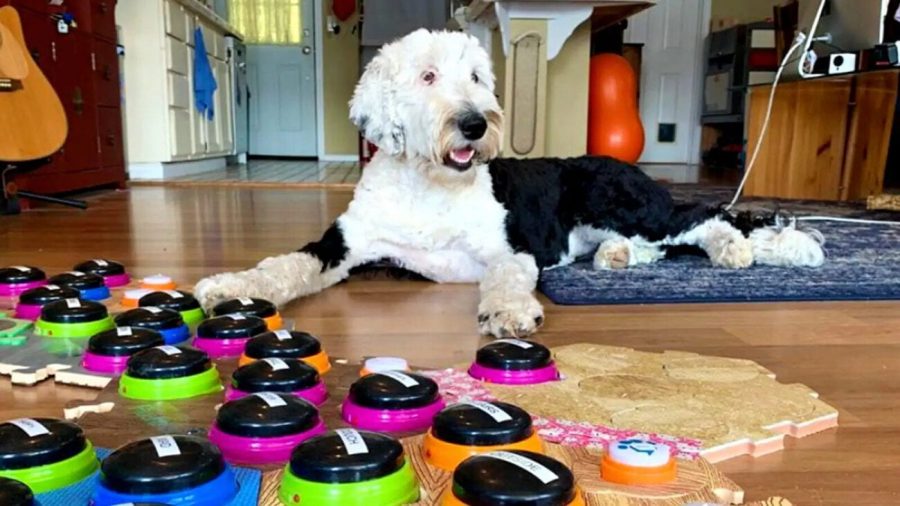Bunny, the “Talking” TikTok Dog, Goes Viral
December 1, 2020
Since the rise of TikTok popularity, the media has been introduced to far more diverse content from creators all around the world. Among many trends, creative content avenues, and new creators, an account—or rather, a dog’s—has stolen the attention of millions across the platform. Bunny, a sheepadoodle found under the account name @what_about_bunny, can supposedly talk and communicate with her owner Alexis Devine. Through the usage of various buttons with pre-recorded words and phrases, Bunny has shocked the global Internet through her apparent ability to “speak.” Standing with over 5 million followers, and over 90 million likes across all content, Bunny has compelled the interest of many.
Devine was initially inspired to try communicating with Bunny by Christina Hunger, a speech-language pathologist. Hunger had used a similar technique to communicate with her own dog Stella, which brought Devine to begin her “experiment.”
Devine began her experience using the FluentPet, which is a system of HexTiles and buttons that use recordings to project audible words and phrases, in a means to facilitate pet communication. Devine began by placing a button by the door. Once pushed, the button would say “outside,” and Devine would allow Bunny to go out. Over time, Bunny began to associate the button with going outside, and her responses to the button gradually became more and more consistent. Devine then began to add additional buttons of various meanings, to which Bunny quickly adapted. With nearly 100 buttons today, Bunny is able to string together words and phrases in order to communicate with her owner. “Through a series of thousands of tiny reinforcements, she learns the meaning of each button,” Devine said. “It didn’t take us long before she was consistently smashing the play button and grabbing a tug toy, bringing it over to us, demanding interaction in that way.”
Bunny’s astounding progress and rise to the public eye has recruited her to partake in a research study conducted by Federico Rossano and Leo Trottier at the Comparative Cognition Lab at the University of California. CleverPet, an organization founded by Trottier himself, designs games that explore the limits of communication between pets and their owners. Among its many innovations and game systems, CleverPet also developed the FluentPet, which was also inspired by Christina Hunger’s work. Having taken particular interest in Bunny, Trottier reached out to Devine to collaborate in the open study.
However, many have been quick to criticize Devine’s work and Bunny’s “progress.” They question the validity of Bunny’s supposed communication skills, and whether or not the account is simply an act in search of relevance and fame. While Devine herself admits that she has no direct qualifications to move forward with her personal studies, and thus has addressed the skeptics, including herself. Devine admits to the vaguarities and questions that remain in the study, such as how it is ambiguous whether Bunny truly understands what she is saying or she is simply connecting buttons to familiar rewards or outcomes through operant conditioning—a process of conditioning a pattern of certain behaviors in response to certain stimuli through repetition. Regardless, Bunny appears to be making great progress in her connection of buttons to more expansive ideas. And while affirmative evidence to suggest Bunny’s true abilities to understand words and concepts has yet to be seen, the study continues to move forward with a bright outlook.
“We know animals can communicate basically about things in their immediate environment,” Trottier disclosed to Bustle. “And while we don’t know if they can do more sophisticated things, there is suggested evidence that the linguistic abilities are way beyond what we thought.”
Bunny’s collection of words continues to grow and expand. Her abilities to “communicate” with Devine has not only strengthened their connection to unprecedented extremes, but has also opened the potential for means of sharing significant information that could potentially change the dynamics between human-animal relationships moving forward.
In an interview conducted by Mashable, Devine shared an experience that had hallmarked Bunny’s progress towards evident communication. Bunny had pressed a question mark button on her board and followed by pressing an “ouch” button. Although at first, Devine was unsure of what Bunny had meant to express, she was quickly made aware of a cut on Bunny’s nose that had become infected. Devine had initially fought her own skepticism as she contemplated the idea of whether or not Bunny had intentionally, knowingly alerted her of her injury. “[Regardless,] I thought the potential of that was pretty powerful,” Devine said. “What if our dogs could tell us specifically when a certain part of their body was in pain?”
The future for augmentative and alternative communication has continued to grow, with figures such as Bunny bringing more and more attention to the matter.
“I definitely have considered myself a hopeful skeptic,” Devine said. “And the more I think about it, I’m not even sure what I’m hopeful for, because the process is so fascinating in and of itself that it doesn’t necessarily have to lead anywhere for it to be engaging for me and for her.”

















































































































































